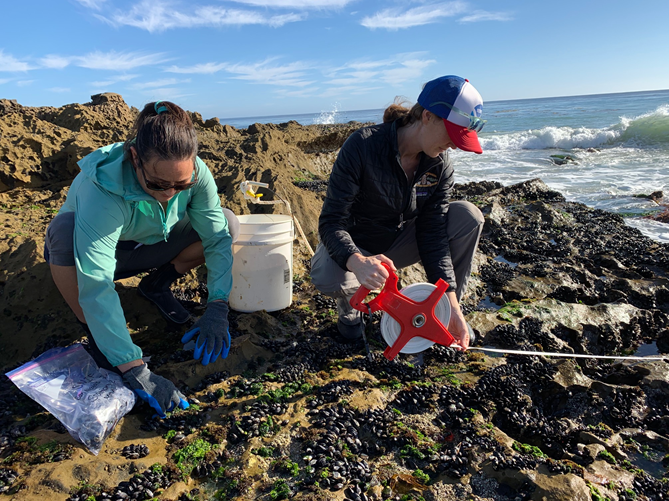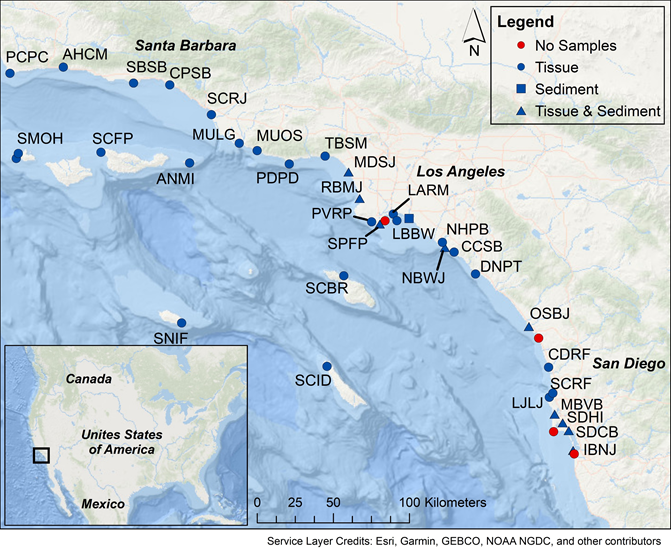
The Mussel Watch Program has monitored the nation’s coastal waters for chemical contaminants since 1986 and in recent decades has expanded its monitoring to include trace metals, legacy contaminants, and contaminants of emerging concern (CECs). In 2018, the program collected mussel (Mytilus sp.) samples from a network of 34 sites and sediment samples from a network of 10 sites in the Southern California Bight. Results from this study will support a better understanding of the sources, fate, and transport of contaminants in the region and will fill important data gaps for local stakeholders.
Why We Care
California marine ecosystems are some of the best studied in the world and have human-ecosystem interactions dating back 13,000 years to when native coastal peoples began developing complex fishing, hunting, and economic trade systems (Scarborough et al., 2022). California’s current ocean economy is dominated by tourism and recreation, marine transportation, and offshore mineral extraction (NOAA Office for Coastal Management, 2015). With nearly two-thirds of the California population residing in coastal counties, the health and water quality of coastal ecosystems is heavily tied to human activities in the region (NOAA Office for Coastal Management, 2015). Thousands of chemical contaminants from many land-based point and nonpoint sources accumulate in the Southern California Bight every day, compromising water quality and, consequently, threatening human and ecosystem health.
Previous studies in the region have investigated legacy contaminants, such as trace elements and persistent organic pollutants (e.g., polychlorinated biphenyls (PCBs), organochlorine pesticides, chlordane, and polycyclic aromatic hydrocarbons (PAHs)). These research and monitoring efforts have helped managers limit the impact that legacy contaminants have on coastal ecosystems, but such efforts are lacking for the increasing number of new and unregulated compounds known as contaminants of emerging concern (CECs), many of which are known to be harmful to people, animals, and the environment. In response to resource managers’ concerns about the extent and impact of these chemical stressors, the Mussel Watch Program conducted a basin-wide survey in 2018 to assess the magnitude and distribution of a suite of CECs, metals, and legacy contaminants in the Southern California Bight.
What We Are Doing
The Mussel Watch Program uses an ecosystem-based approach to monitoring, which entails measuring the concentration of chemical contaminants in sediments and the tissues of indigenous bivalves, such as oysters and mussels, as a way to evaluate local environmental quality. Bivalves are used as indicator organisms for chemical pollution because they tend to bioaccumulate contaminants from the large amounts of water they filter, they have limited mobility, and they are found throughout the U.S. coastal zone.
The program currently analyzes sediment and bivalves for both legacy contaminants and CECs. Legacy contaminants, monitored by Mussel Watch since 1986, include compounds such as chlordanes, chlorobenzenes, dichlorodiphenyltrichloroethane (DDT), dieldrins, endosulfans, hexachlorocyclohexanes (HCHs), butyltins, PAHs, and PCBs. The monitoring of CECs began in 2009 and includes contaminants such as alkylphenols, alternative flame retardants, current-use pesticides, (per- and polyfluoroalkyl substances (PFASs), polybrominated diphenyl ether (PBDEs), polybrominated biphenyls (PBBs), and pharmaceuticals and personal care products. In general, CECs are minimally regulated, not commonly monitored, but potentially toxic chemicals that are finding their way into the environment.
In 2018, Mussel Watch analyzed sediment and mussel (Mytilus sp.) samples from a network of 35 sites in the Southern California Bight for metals, legacy contaminants, and CECs. In this survey, 34 samples of Mytilus sp. and 10 of sediment were collected along the California coast from Point Conception to Punta Colonet following standard Mussel Watch Program protocols. Sites were selected based on recent success of historic site locations and the availability of collaborator support in the region. The national Mussel Watch Program designed the 2018 Southern California Bight chemical stressors survey in collaboration with the Southern California Coastal Water Research Project (SCCWRP).
Benefits of Our Work
This study supplies much-needed data to the national Mussel Watch Program and local stakeholders and managers in the Southern California Bight and informs water quality data used by coastal resource managers to develop effective, long-term policies to protect ecosystem services provided by the Southern California Bight.

